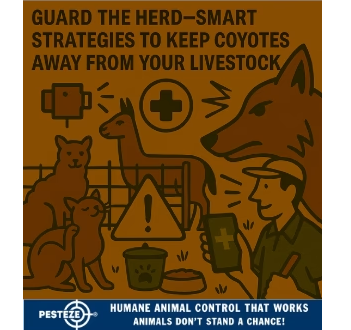HOW TO KEEP COYOTES AWAY FROM YOUR LIVESTOCK

HOW TO KEEP COYOTES AWAY FROM YOUR LIVESTOCK
SUMMARY
Coyotes are intelligent, adaptable predators that pose a serious threat to livestock—especially goats, sheep, poultry, and calves. This guide outlines humane, effective ways to deter coyotes from your property using fencing, deterrents, guardian animals, and smart land management. Protect your animals without harming the ecosystem.
FEATURES
-
Install Predator-Proof Fencing: Use tall, buried fencing with electric wires to block digging and jumping.
-
Use Motion-Activated Deterrents: Lights, alarms, and sprinklers startle coyotes and discourage repeat visits.
-
Employ Guardian Animals: Livestock guardian dogs, donkeys, and llamas can detect and confront intruders.
-
Secure Feed and Waste: Remove food sources like pet food, compost, and spilled grain to reduce attraction.
-
Rotate Grazing Areas: Avoid predictable patterns—move animals frequently to confuse hunting habits.
-
Monitor with Trail Cameras: Track coyote movement and activity to adjust defenses proactively.
GUIDE DESCRIPTION
Coyotes are cunning predators that can cause devastating losses to livestock if not properly managed. They’re known for their ability to dig, climb, and adapt to human activity, making them one of the most challenging threats to rural farms. But with the right strategies, you can keep them at bay.
Start with fencing. A predator-proof fence should be at least 6 feet tall, with an additional overhang or electric wire to prevent climbing. Bury the bottom 12–18 inches or add a wire apron to block digging. Coyotes are persistent, so your fence must be both tall and deep.
Motion-activated deterrents are highly effective. Lights, sirens, and sprinklers can startle coyotes and make your property less appealing. Rotate devices and change their placement regularly to prevent habituation.
Guardian animals are a natural defense. Livestock guardian dogs like Anatolian Shepherds or Great Pyrenees are bred to protect herds. Donkeys and llamas also serve as territorial protectors, often confronting coyotes directly.
Coyotes are opportunistic feeders. Secure all food sources—this includes pet food, compost, trash, and spilled livestock feed. Clean up regularly and store supplies in sealed containers to reduce attraction.
Rotating grazing areas can disrupt hunting patterns. Coyotes learn routines quickly, so changing where and when your animals graze makes it harder for them to plan an attack.
Trail cameras are invaluable tools. They help you monitor coyote activity, identify entry points, and adjust your defenses accordingly. Knowing when and where coyotes appear allows you to respond with precision.
With layered defenses and proactive management, you can protect your livestock and maintain a safe, balanced farm environment.
- Amy Chang


Comments 0